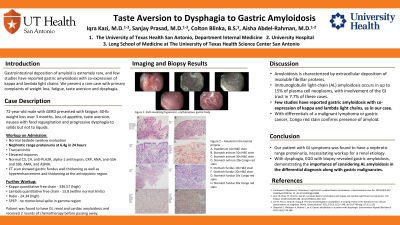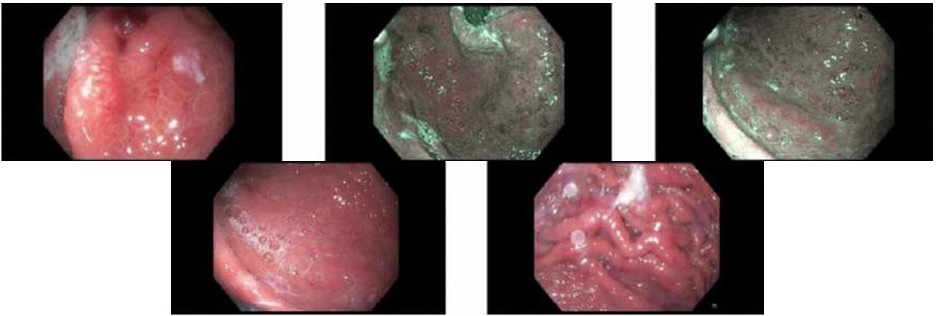Monday Poster Session
Category: Stomach
P2789 - Taste Aversion to Dysphagia to Gastric Amyloidosis
Monday, October 23, 2023
10:30 AM - 4:15 PM PT
Location: Exhibit Hall

Has Audio
.jpg)
Iqra Kazi, MD
UT Health San Antonio
San Antonio, TX
Presenting Author(s)
Iqra Kazi, MD1, Sanjay Prasad, MD2, Aisha Abdel-Rahman, MD2
1UT Health San Antonio, San Antonio, TX; 2University of Texas Health Science Center San Antonio, San Antonio, TX
Introduction: Gastrointestinal deposition of amyloid is extremely rare, and few studies have reported gastric amyloidosis with co-expression of kappa and lambda light chains. We present a rare case with primary complaints of weight loss, fatigue, taste aversion and dysphagia.
Case Description/Methods: A 72-year-old male with GERD presented with fatigue, 40-lb weight loss over 3 months, loss of appetite, taste aversion, nausea with food regurgitation and progressive dysphagia to solids but not to liquids. Bedside swallow evaluation was normal. He had a recent EGD at an outside hospital, and no biopsies were taken. Labs showed nephrotic range proteinuria at 6.4g in 24 hours, transaminitis and elevated troponin, followed by normal C3, C4, anti-PLA2R, alpha-1 antitrypsin, CRP, ANA, anti-SSA and SSB, AMA, and ASMA. Further workup revealed kappa quantitative free chain elevated to 336.57, lambda normal at 13.8 and an elevated ratio of 24.34. SPEP showed hypoalbuminemia with no monoclonal spike in gamma region. CT scan showed gastric fundus wall thickening, hyperenhancement and thickening at the antropyloric region. EGD showed areas of thickened folds with erythema, edema, congestion, and nodularity in the greater curvature of stomach. Duodenal biopsy showed focal lymphoid aggregate; antrum and fundus of the stomach biopsy revealed diffuse lamina propria amyloid deposition confirmed by Congo red special stain. Kappa and lambda highlight scattered polytypic plasma cells consistent with a plasma cell neoplasm. He was found to have gastric, renal and cardiac amyloidosis and had received 2 rounds of chemotherapy before passing away.
Discussion: Amyloidosis is characterized by extracellular deposition of insoluble fibrillar proteins. Few studies have reported gastric amyloidosis with co-expression of kappa and lambda light chains. Immunoglobulin light-chain (AL) amyloidosis occurs in up to 15% of plasma cell neoplasms; involvement of the GI tract is 7.7% of these cases. EGD findings present similar to our patient along with polypoid protrusions and depressed lesions. With differentials of a malignant lymphoma or gastric cancer, Congo red stain confirms presence of amyloid. Our patient with GI symptoms was found to have a nephrotic range proteinuria, necessitating workup for a renal etiology. With dysphagia, EGD led to revealing gastric amyloidosis, demonstrating the importance of considering AL amyloidosis in the differential diagnosis along with gastric malignancies.

Disclosures:
Iqra Kazi, MD1, Sanjay Prasad, MD2, Aisha Abdel-Rahman, MD2. P2789 - Taste Aversion to Dysphagia to Gastric Amyloidosis, ACG 2023 Annual Scientific Meeting Abstracts. Vancouver, BC, Canada: American College of Gastroenterology.
1UT Health San Antonio, San Antonio, TX; 2University of Texas Health Science Center San Antonio, San Antonio, TX
Introduction: Gastrointestinal deposition of amyloid is extremely rare, and few studies have reported gastric amyloidosis with co-expression of kappa and lambda light chains. We present a rare case with primary complaints of weight loss, fatigue, taste aversion and dysphagia.
Case Description/Methods: A 72-year-old male with GERD presented with fatigue, 40-lb weight loss over 3 months, loss of appetite, taste aversion, nausea with food regurgitation and progressive dysphagia to solids but not to liquids. Bedside swallow evaluation was normal. He had a recent EGD at an outside hospital, and no biopsies were taken. Labs showed nephrotic range proteinuria at 6.4g in 24 hours, transaminitis and elevated troponin, followed by normal C3, C4, anti-PLA2R, alpha-1 antitrypsin, CRP, ANA, anti-SSA and SSB, AMA, and ASMA. Further workup revealed kappa quantitative free chain elevated to 336.57, lambda normal at 13.8 and an elevated ratio of 24.34. SPEP showed hypoalbuminemia with no monoclonal spike in gamma region. CT scan showed gastric fundus wall thickening, hyperenhancement and thickening at the antropyloric region. EGD showed areas of thickened folds with erythema, edema, congestion, and nodularity in the greater curvature of stomach. Duodenal biopsy showed focal lymphoid aggregate; antrum and fundus of the stomach biopsy revealed diffuse lamina propria amyloid deposition confirmed by Congo red special stain. Kappa and lambda highlight scattered polytypic plasma cells consistent with a plasma cell neoplasm. He was found to have gastric, renal and cardiac amyloidosis and had received 2 rounds of chemotherapy before passing away.
Discussion: Amyloidosis is characterized by extracellular deposition of insoluble fibrillar proteins. Few studies have reported gastric amyloidosis with co-expression of kappa and lambda light chains. Immunoglobulin light-chain (AL) amyloidosis occurs in up to 15% of plasma cell neoplasms; involvement of the GI tract is 7.7% of these cases. EGD findings present similar to our patient along with polypoid protrusions and depressed lesions. With differentials of a malignant lymphoma or gastric cancer, Congo red stain confirms presence of amyloid. Our patient with GI symptoms was found to have a nephrotic range proteinuria, necessitating workup for a renal etiology. With dysphagia, EGD led to revealing gastric amyloidosis, demonstrating the importance of considering AL amyloidosis in the differential diagnosis along with gastric malignancies.

Figure: Figure 1: EGD visualizing hyperemic, erythematous gastric body
Disclosures:
Iqra Kazi indicated no relevant financial relationships.
Sanjay Prasad indicated no relevant financial relationships.
Aisha Abdel-Rahman indicated no relevant financial relationships.
Iqra Kazi, MD1, Sanjay Prasad, MD2, Aisha Abdel-Rahman, MD2. P2789 - Taste Aversion to Dysphagia to Gastric Amyloidosis, ACG 2023 Annual Scientific Meeting Abstracts. Vancouver, BC, Canada: American College of Gastroenterology.
